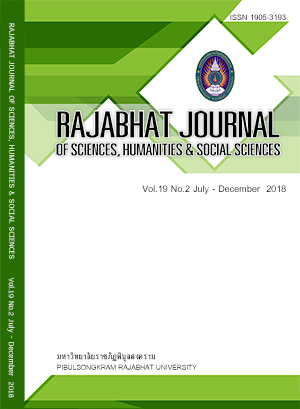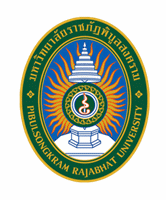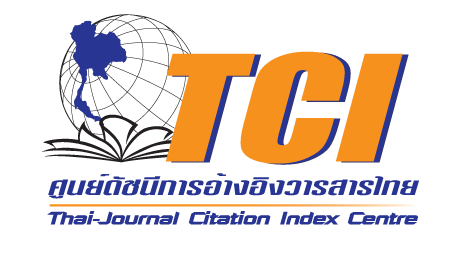การตรวจสอบพฤกษเคมีเบื้องต้น การหาปริมาณฟีนอลิกและฟลาโวนอยด์ทั้งหมดและฤทธิ์ต้านอนุมูลอิสระจากต้นกุ่มน้ำ
คำสำคัญ:
กุ่มน้ำ, พฤกษเคมี, ฤทธิ์ต้านอนุมูลอิสระบทคัดย่อ
งานวิจัยนี้มีวัตถุประสงค์เพื่อตรวจสอบหาสารพฤกษเคมีเบื้องต้น หาปริมาณสารฟีนอลิกทั้งหมด ฟลาโวนอยด์ทั้งหมดและทดสอบฤทธิ์ต้านอนุมูลอิสระในสารสกัดจากเอทานอลของดอก ใบอ่อน ใบแก่ กิ่ง และเปลือกจากต้นกุ่มน้ำ Crateva magna (Lour.) DC. ทดสอบฤทธิ์ต้านอนุมูลอิสระด้วยวิธี DPPH, ABTS และ FRAP หาปริมาณสารฟีนอลิกทั้งหมดและฟลาโวนอยด์ทั้งหมด ใช้วิธี Folin-Ciocalteu และ Aluminium chloride colorimetric ตามลำดับ ผลการตรวจสอบหาสารพฤกษเคมีเบื้องต้นพบสารฟีนอลิก ฟลาโวนอยด์ แทนนินและน้ำมันหอมระเหยอยู่ในสารสกัดจากส่วนต่าง ๆ ของพืช ตัวอย่างสารสกัดจากใบอ่อนให้ปริมาณฟีนอลิกทั้งหมดและฟลาโวนอยด์ทั้งหมดมากที่สุดเมื่อเปรียบเทียบกับสารสกัดอื่นมีค่าเท่ากับ 5.73 ± 0.28 mg GAE/g DW และ 56.62 ± 0.23 mg RUE/g DW ตามลำดับโดยวิธี DPPH และ ABTS มีค่า IC50 เท่ากับ 0.30 ± 0.02 และ 0.92 ± 0.04 mg/ml ตามลำดับ และมีค่า FRAP เท่ากับ 13.06 ± 0.08 FeSO4/g DW สรุปได้ว่าสารสกัดจากใบอ่อนของพืชชนิดนี้มีปริมาณสารฟีนอลิกและฟลาโวนอยด์ที่สูงและมีคุณสมบัติต้านอนุมูลอิสระที่ดีมาก เมื่อเทียบกับสารสกัดอื่น ๆ และยังพบว่าปริมาณสารฟีนอลิกและฟลาโวนอยด์มีความสัมพันธ์ต่อฤทธิ์ต้านอนุมูลอิสระ ดังนั้นสารสกัดจากกุ่มน้ำจึงเป็นแหล่งสารต้านอนุมูลอิสระที่ดีและสามารถนำไปพัฒนาในด้านเภสัชภัณฑ์ได้ต่อไป
เอกสารอ้างอิง
Adebiyi LE, Olayemi FO, Ning-Hua T. et al. In vitro antioxidant activity, total phenolic and flavonoid contents of ethanol extract of stem and leaf of Grewia carpinifolia, Beni-Suef University Journal of Basic and Applied Sciences. 2017; 6: 10-14.
Banjarnahor SDS, Artanti N. Antioxidant properties of flavonoids, Medical Journal of Indonesia. 2014; 23(4): 239-244.
Behera S, Behera B, Barik DP. et al. Phytochemical analysis of the leaf, flower, and bark of a medicinal plant, Crataeva magna (Lour.) DC, Asian Journal of Pharmaceutical and Clinical Research. 2016; 9(1): 177-178.
Brighents IMC, Dias M, Verdi LG. et al. Antioxidant Activity and Total phenolic content of some Brazilian species, Pharmaceutical Biology. 2007; 45(2): 156-161.
Chuakul W. Indigenous medicinal plants used as paralysis remedy, Thai Pharmaceutical and Health Science Journal. 2010; 5(3): 193-201.
Embuscado EM. Spice and herbs: natural sources of antioxidants-a mini review, Journal of Functional Foods. 2015; 18: 811-819.
Kaur M, Asthir B, Mahajan, G. Variation in antioxidants, bioactive compounds and antioxidant capacity ingerminated and ungerminated grains of ten rice cultivars, Rice Science. 2017; 24(6): 349-359.
Kumar S. The importance of antioxidant and their role in pharmaceutical science-a review, Asian Journal of Research in Chemistry and Pharmaceutical Sciences. (2014); 2(1): 27-44.
Loganayaki N, Manian S. Evalution of indian sacred tree Crataeva magna (Lour.) DC. for antioxidant activity and inhibition of key enzymes relevant to hyperglycemia, Journal of Bioscience and Bioengineering. 2012; 113(3): 378-380.
Mandal S, Yadav S, Yadav S. et al. Antioxidant: a review, Journal of Chemical and Pharmaceutical Research. 2009; 1(1): 102-104.
Mekab SK, Mishra S, Sahoo S. et al. Antiurolithiatic activity of Crataeva magna Lour. bark, Indian Journal of Natural Products and Resources. 2011; 2(1): 28-33.
Neamsuvan O, Sengnon N, Seemaphrik N. et al. A survey of medicinal plants around upper songkhla lake, African Journal of Traditional, Complementary and Alternative Medicines. 2015; 12(2): 133-143.
Pang Y, Ahmed S, Xu Y. et al. Bound phenolic compounds and antioxidant properties of whole grain and bran of white, red and black rice, Food Chemistry. 2018; 240: 212-221.
Pietta PG. Flavonoids as antioxidants, Journal of Natural Products. 2000; 63: 1035-1042.
Pramai P, Jiamyangyen S. Chemometric classification of pigmented rice varieties based on ant oxidative properties in relation to color, Songklanakarin Journal of Science and Technology. 2016; 35(5): 463-472.
Radha SR, Doraiswamy R. HPTLC finger printing analysis of the aqueous bark extract of Crateva magna Lour. (DC.) for terpenoid content, World Journal of Pharmacy and Pharmaceutical Sciences. 2017; 6 (7): 1489-1495.
Radha SR, Vijayakumari B. Phytochemical investigation of the extracts of Crateva magna Lour.,JPR: BioMedRx: An International Journal. 2013); 1(8): 848-851.
Ramu RS, Doraiswamy R, Yadav HM. Antiurolithiatic sctivity of aqueous bark extract of Crat aeva magna Lour. (DC.), International Journal of Research in Ayurveda and Pharmacy. 2017; 8(2): 271-278.
Saxena M, Saxena J, Pradhan A. Flavonoids and phenolic acids as antioxidants in plants and human health, International Journal of Pharmaceutical Sciences Review and Research. 2012; 12(2): 130-134.
Shahidi P, Janitha PK, Wanasundara PD. Phenolic antioxidants. Critical Reviews in Food Science and Nutrition. 2012; 32(1): 67-103.
Tapas AR, Sakarkar DM, Kakde RB. Flavonoids as nutraceuticals: a review, Tropical Journal of Pharmaceutical Research. 2008; 7(3): 1089-1099.
Wanyo P, Schoenlechner R, Meeso N. et al. Antioxidant activities and sensory properties of rice bran with marigold tea, Food and Applied Bioscience Journal. 2014; 2(1): 1-14.
Yadav A, Kumari R, Yadav A. et al. Antioxidant and its functions in human body-a review, Research in Environment and Life Sciences. 2016; 9(11): 1328-1331.
ดาวน์โหลด
เผยแพร่แล้ว
รูปแบบการอ้างอิง
ฉบับ
ประเภทบทความ
สัญญาอนุญาต
Each article is copyrighted © by its author(s) and is published under license from the author(s).










